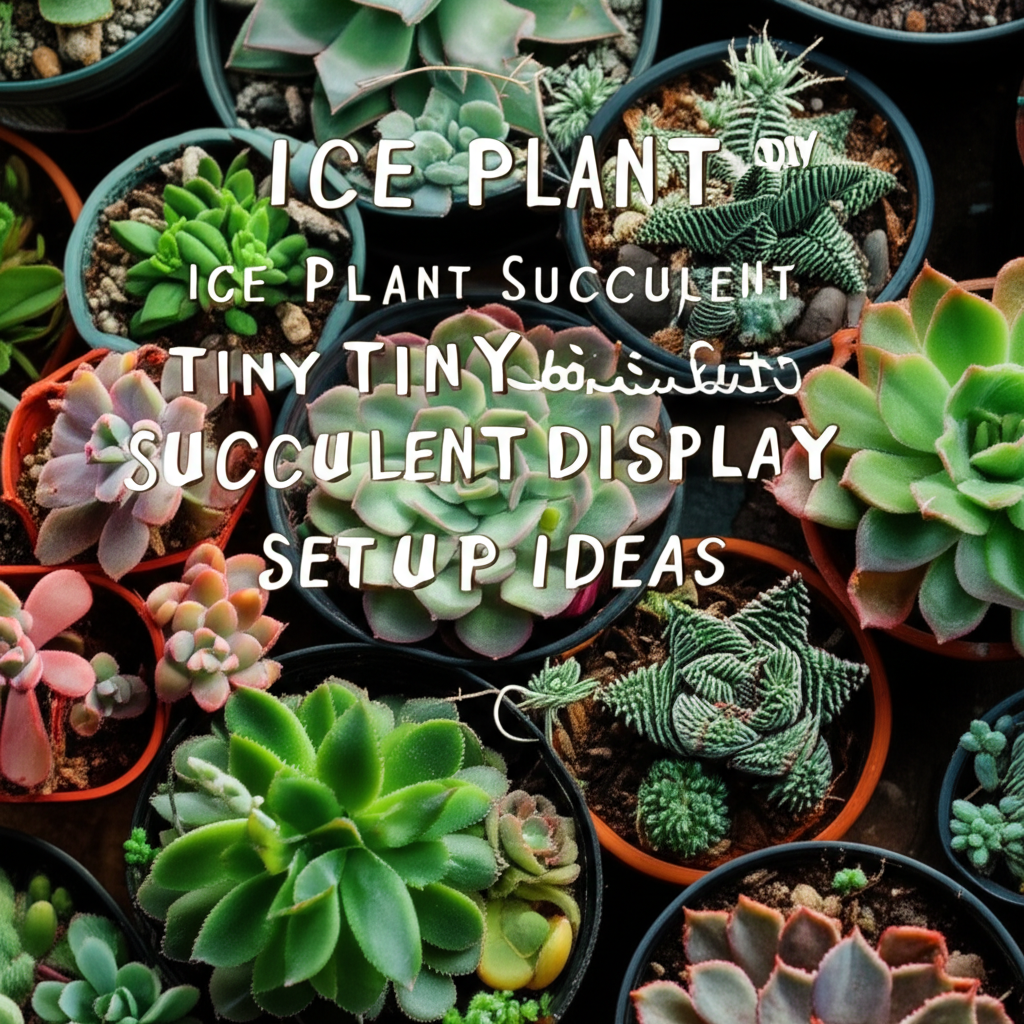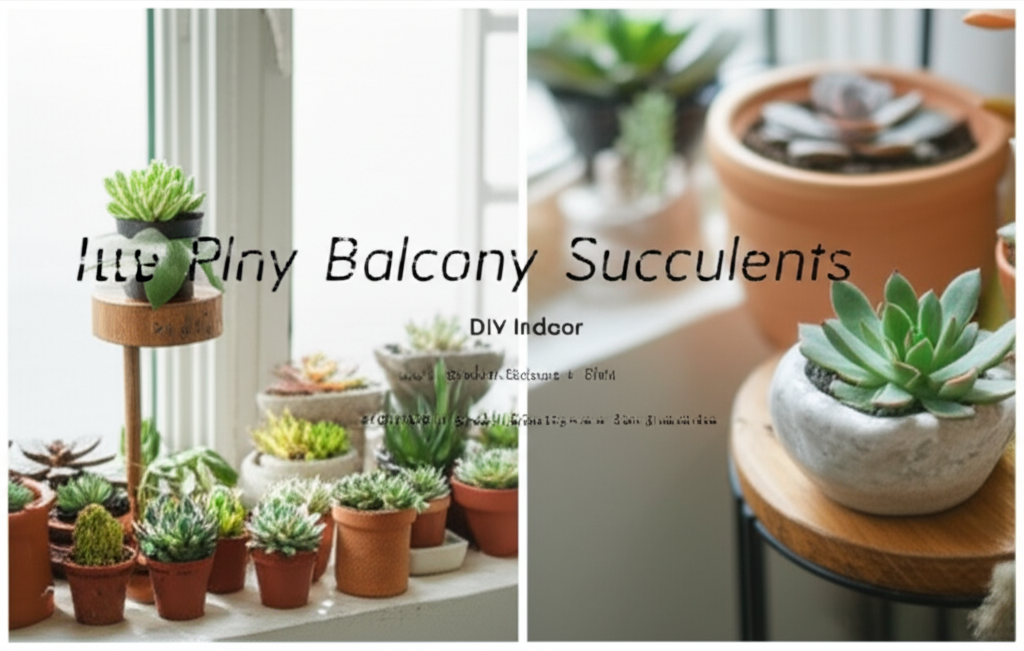Introduction to Ice Plant Succulents for Your Indoor Oasis
Ice plants, scientifically known as Mesembryanthemums, are a fascinating group of succulents renowned for their unique, crystalline structures that give them their name. These tiny, translucent papillae not only create a captivating visual effect but also help the plant collect moisture from the air, making them surprisingly resilient. For those with limited space, particularly on tiny balconies or indoors, ice plants offer a perfect solution for creating vibrant, low-maintenance succulent displays. Their compact growth habit and diverse varieties, ranging from ground-hugging creepers to more upright forms, make them incredibly versatile for DIY projects. This article will guide you through the exciting world of ice plant succulents, offering creative and practical ideas for setting up stunning indoor and tiny balcony succulent displays.
Why Ice Plants Are Ideal for Small Spaces
Small spaces, like tiny balconies and indoor nooks, present unique challenges and opportunities for plant enthusiasts. Ice plants excel in these environments due to several key characteristics:
- Compact Size: Most ice plant varieties remain relatively small, preventing them from overwhelming limited areas.
- Drought Tolerance: As succulents, they require infrequent watering, minimizing the risk of overwatering in enclosed spaces where drainage might be a concern.
- Sunlight Requirements: Many ice plants thrive in bright, indirect sunlight, which is often plentiful on balconies or near windows.
- Visual Appeal: The shimmering, jewel-like appearance of the papillae adds a unique and eye-catching element to any display, even in small arrangements.
- Low Maintenance: They are generally pest-resistant and don’t require constant pruning or feeding, making them ideal for busy individuals or beginners.
Key Facts About Ice Plant Succulents

Before diving into DIY setup ideas, understanding the fundamental needs of ice plants is crucial for their success.
| Fact | Description |
|---|---|
| Scientific Name | Mesembryanthemum spp. |
| Common Names | Ice Plant, Dew Plant, Midday Flower, Fig Marigold |
| Light Needs | Full sun to bright, indirect light. Many varieties tolerate partial shade. |
| Watering Needs | Allow soil to dry out completely between waterings. Overwatering is the most common killer. |
| Soil Type | Well-draining succulent or cactus mix. A sandy, gritty mix is ideal. |
| Temperature Tolerance | Prefer warm temperatures (65-80°F / 18-27°C). Protect from frost. |
| Bloom Time | Varies by species, but many bloom in spring and summer, often opening flowers in sunlight. |
| Propagation | Easily propagated from stem cuttings or seeds. |
Choosing the Right Ice Plant Varieties for Your Display
The diversity within the Mesembryanthemum genus means there’s an ice plant suited for almost any aesthetic. When planning your DIY setup, consider the growth habit and mature size of the varieties you select.
Popular Ice Plant Varieties and Their Characteristics
- Delosperma cooperi (Hardy Ice Plant): Known for its vibrant magenta-pink flowers and spreading habit. It’s remarkably cold-hardy for a succulent, making it a great choice for balconies that experience cooler temperatures.
- Lithops spp. (Living Stones): While not strictly “ice plants” in the common parlance of papillae, they are often grouped with Mesembryanthemums due to their unique appearance and succulent nature. Their stone-like bodies and often hidden flowers are a conversation starter. They are very slow-growing and require extremely well-draining soil and minimal water.
- Conophytum spp. (Cone Plants): Another group often associated with Mesembryanthemums, these tiny, pebble-like succulents form dense clusters and produce delicate, star-shaped flowers. They are excellent for miniature arrangements.
- Aptenia cordifolia (Heartleaf Ice Plant): A vigorous, trailing ice plant with heart-shaped leaves. It produces small, bright pink or purple flowers. Its fast growth makes it ideal for cascading displays.
- Mesembryanthemum crystallinum (Common Ice Plant): This species is known for its striking, silvery-white, crystalline foliage. It can be a bit more sprawling and is often treated as an annual in cooler climates but is a stunning specimen for any display.
DIY Indoor Tiny Balcony Succulent Display Setup Ideas
Now, let’s get creative with how you can showcase your ice plants in small spaces. The key is to think vertically, incorporate interesting containers, and group plants with similar needs.
Vertical Displays for Tiny Balconies
Maximizing vertical space is essential for tiny balconies.
Hanging Planters and Wall-Mounted Gardens
- Repurposed Pallets: Create a rustic vertical garden by mounting a treated wooden pallet against a wall. Line the back and sides with landscaping fabric, fill with succulent soil, and plant your ice plants in the horizontal slats. The trailing varieties will spill over beautifully.
- Tiered Shelving Units: A small, multi-tiered shelf unit can hold several pots of ice plants at different heights, creating a dynamic display. Ensure the unit is stable and can withstand wind if placed outdoors.
- Macrame Hangers: Use macrame plant hangers to suspend pots from balcony railings or overhead structures. This adds a bohemian touch and keeps floor space clear.
- Wall Pockets: Fabric or felt wall pockets are lightweight and can be easily attached to a balcony wall. Fill them with well-draining soil and create mini landscapes with different ice plant varieties.
Hanging Baskets with Cascading Ice Plants
Choose varieties like Aptenia cordifolia for a dramatic cascading effect in hanging baskets. Mix in some trailing Sedums or String of Pearls for added texture and visual interest. Ensure the basket has good drainage holes.
Indoor Displays for Nooks and Windowsills
Bring the shimmering beauty of ice plants indoors to brighten up any corner.
Terrarium-Style Displays (Open Terrariums Only)
Ice plants, like most succulents, do not thrive in closed terrariums due to high humidity. Opt for open terrariums or large glass bowls.
- Layered Gravel and Sand: Create a visually appealing base in a glass bowl with layers of colorful gravel and coarse sand.
- Careful Placement: Arrange your ice plants, perhaps with some interesting driftwood or small decorative stones, allowing ample airflow around each plant.
- Drainage Layer: While the soil itself should be well-draining, a thin layer of gravel at the bottom of the bowl can offer an extra buffer against stagnant water, though this is debated among succulent growers. The primary focus must remain on the soil mix.
Dish Gardens and Shallow Containers
Shallow containers are perfect for creating cohesive arrangements of multiple ice plants.
- Mixed Arrangements: Combine different ice plant varieties with contrasting colors and textures in a shallow ceramic pot or a repurposed tray.
- Focal Point: Use a slightly taller or more uniquely shaped ice plant as a focal point, surrounded by smaller, trailing varieties.
- Decorative Toppings: Add a layer of decorative gravel, pebbles, or even small shells on top of the soil to enhance the aesthetic and help retain soil moisture slightly, while still allowing for good drainage.
Container Choices and Soil Preparation
The right container and soil are paramount for the health of your ice plants.
Container Essentials
- Drainage Holes: This cannot be stressed enough. All containers MUST have drainage holes to prevent root rot.
- Material: Terracotta pots are excellent as they are porous, allowing for better airflow and faster drying of the soil. Glazed ceramic, plastic, or even repurposed containers can work as long as they have drainage.
- Size: Choose containers that are proportionate to the size of your ice plants. While they don’t need enormous pots, ensure there’s enough room for roots to grow.
The Perfect Soil Mix
A well-draining soil mix is critical. You can buy specialized succulent and cactus mixes, or create your own:
- DIY Mix Ratio: A common and effective DIY mix is 2 parts potting soil, 1 part coarse sand (horticultural or builder’s sand, not play sand), and 1 part perlite or pumice.
- Benefits: This blend provides aeration, prevents waterlogging, and allows roots to breathe, mimicking the arid conditions ice plants naturally prefer.
Planting and Care for Your Ice Plant Display
Setting up is just the first step; proper care ensures your display thrives.
Planting Your Ice Plants
- Prepare Containers: Ensure containers are clean and have drainage holes.
- Add Soil: Fill containers with your prepared well-draining succulent mix.
- Arrange Plants: Gently remove ice plants from their nursery pots, shaking off excess soil. Arrange them in your chosen container, considering their mature size and growth habits.
- Planting Depth: Plant them at the same depth they were in their original pots.
- Watering After Planting: It’s generally advised to wait a few days to a week after planting or repotting before watering. This allows any disturbed roots to heal, reducing the risk of rot.
Ongoing Care and Maintenance
A table outlining care aspects and associated pros/cons can be very helpful for DIYers.
| Care Aspect | How-To | Pros | Cons |
|---|---|---|---|
| Watering | Water thoroughly only when the soil is completely dry. Check by sticking your finger about an inch into the soil. Reduce watering significantly in winter. | Promotes healthy root development; prevents rot. | Overwatering is detrimental; requires vigilance. |
| Light | Provide at least 6 hours of bright, indirect sunlight daily. Some varieties can tolerate full sun, but intense afternoon sun can scorch leaves. | Encourages compact growth and vibrant coloration; promotes flowering. | Too little light leads to leggy, weak growth; too much direct sun can burn. |
| Soil & Drainage | Use a gritty, well-draining succulent mix. Ensure containers have drainage holes. | Prevents root rot and fungal diseases. | Requires purchasing or mixing specific soil components. |
| Temperature | Ideal: 65-80°F (18-27°C). Protect from frost. Bring indoors if temperatures drop below freezing. | Promotes optimal growth and flowering. | Vulnerable to cold damage; requires protection in cooler climates. |
| Fertilizing | Feed sparingly during the growing season (spring/summer) with a diluted succulent fertilizer (half-strength). | Can encourage more vigorous growth and flowering. | Over-fertilizing can burn roots; not strictly necessary for most ice plants. |
| Pest Control | Inspect regularly for common succulent pests like mealybugs or spider mites. Treat with insecticidal soap or neem oil if necessary. | Maintains plant health and appearance. | Requires regular inspection and potentially treatment. |
Troubleshooting Common Ice Plant Issues
Even with the best intentions, problems can arise. Understanding common issues will help you keep your ice plant displays looking their best.
Yellowing or Mushy Leaves
This is almost always a sign of overwatering. Ensure you are letting the soil dry out completely between waterings and that your containers have adequate drainage.
Stretched or Leggy Growth (Etiolation)
If your ice plants are growing long, thin stems with widely spaced leaves, they are not receiving enough light. Move them to a brighter location.
Brown, Crispy Spots on Leaves
This can indicate sunburn from excessive direct sunlight, especially if the plants are not acclimated to full sun. Provide some shade during the hottest part of the day.
Pest Infestations
Mealybugs (white, cottony masses) and spider mites are common succulent pests. Isolate affected plants and treat with a cotton swab dipped in rubbing alcohol, or use insecticidal soap.
Conclusion: Cultivating Your Shimmering Succulent Haven
Creating a beautiful ice plant succulent display on your tiny balcony or indoors is a rewarding DIY project that brings a touch of natural wonder to even the smallest spaces. By understanding their basic needs, choosing the right varieties, and employing creative display techniques, you can cultivate a thriving, low-maintenance succulent haven. Remember to prioritize drainage, provide ample light, and enjoy the unique, shimmering beauty that only ice plants can offer. Happy planting!


